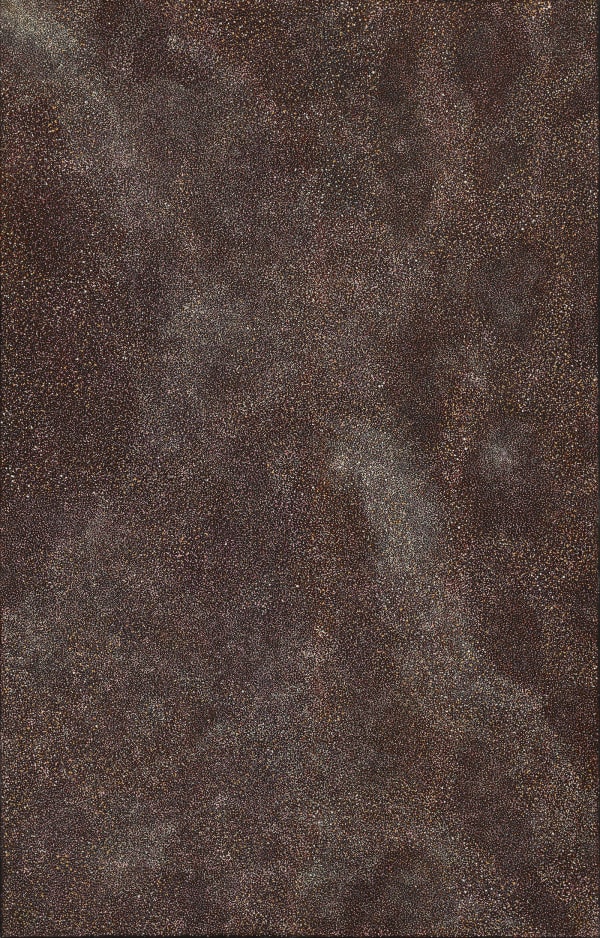Indigenous Masterworks & Tribute to Jorna Newberry
Lennox St. Gallery is pleased to present Indigenous Masterworks & Tribute to Jorna Newberry, an exhibition of paintings and ceramics by First Nations' Artists. You are cordially invited to join us for exhibition drinks on Thursday, 5 June, 6-8pm.
This exhibition celebrates Indigenous Australian artistic traditions through three interconnected narratives: the enduring legacy of the Hermannsburg School, contemporary Western Desert art, and a tribute to the late Jorna Newberry.
Our tribute to Jorna Newberry celebrates a Pitjantjatjara artist whose meticulous technique spoke in a whisper of poise and restraint. Taught by her uncle Tommy Watson, Jorna developed a distinctive voice telling Perentie stories-the great lizard whose tracks guide desert communities to water and food. Using fine nibs to create almost calligraphic marks, her subtle palette of whites, yellows, and caramel against black backgrounds required weeks of meditative work.
The Hermannsburg School, pioneered by Albert Namatjira, synthesized Western watercolour techniques with Aboriginal storytelling. His descendants continue this tradition: Reinhold Inkamala transforms Mount Sonder into meditations on creation, depicting the Arrernte "Sleeping Woman" where physical landscape meets spiritual significance. Gloria Pannka captures the MacDonnell Ranges with luminous precision, while Kevin Namatjira employs vibrant blues and purples to render distant ranges with dreamlike spirituality.
Western Desert works showcase ancient ground painting traditions translated onto canvas. Justin Corby presents Kanpi (Emu) Dreaming, tracing songlines that map both physical and spiritual territories. Walangkura Napanangka's canvases, characterized by masses of small markings in sandy orange, depict sandhills and ancestral women's journeys, transmitting "the power of the desert." Raymond Young's contemporary vessels honor continuing Gunaikurnai shield-making traditions.
Together, these works demonstrate Indigenous Australian art's remarkable continuity while celebrating individual voices. They are carriers of cultural knowledge, maps of Country, and vessels of story-reminders that this remains one of the world's oldest living art traditions.





![Ngintaka - Perentie #34 [JNKM3322024]](https://artlogic-res.cloudinary.com/w_600,c_limit,f_auto,fl_lossy,q_auto/artlogicstorage/metrogallery/images/view/0ce1bb15458afe73c0714bfc10bc6658j/lennoxst.gallery-jorna-newberry-ngintaka-perentie-34-jnkm3322024-2024.jpg)


![Ngintaka – Perentie #1 [JNKM 2]](https://artlogic-res.cloudinary.com/w_600,c_limit,f_auto,fl_lossy,q_auto/artlogicstorage/metrogallery/images/view/7beda358163af2542ca2c64df33f1fb6j/lennoxst.gallery-jorna-newberry-ngintaka-perentie-1-jnkm-2-2022.jpg)
![Ngintaka - Perentie #35 [JNKM3422024]](https://artlogic-res.cloudinary.com/w_600,c_limit,f_auto,fl_lossy,q_auto/artlogicstorage/metrogallery/images/view/e8ee0bd6272dcab3da3826ca2ae96b47j/lennoxst.gallery-jorna-newberry-ngintaka-perentie-35-jnkm3422024-2024.jpg)

![Ngintaka – Perentie #16 [JNKM24522]](https://artlogic-res.cloudinary.com/w_600,c_limit,f_auto,fl_lossy,q_auto/artlogicstorage/metrogallery/images/view/58172ccc62c6112ae5d40a53bd653bc9j/lennoxst.gallery-jorna-newberry-ngintaka-perentie-16-jnkm24522-2022.jpg)

![Ngintaka – Perentie #17 [JNKM25522]](https://artlogic-res.cloudinary.com/w_600,c_limit,f_auto,fl_lossy,q_auto/artlogicstorage/metrogallery/images/view/00f09229e239143a2a7a79c88a2ebe34j/lennoxst.gallery-jorna-newberry-ngintaka-perentie-17-jnkm25522-2022.jpg)

















